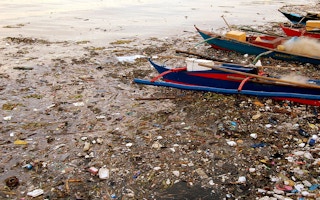Metro Manila is now home to more than 12 million people. As with many other megacities in Asia, waste collection and disposal is a major environmental issue.
Currently about 35,000 tons of municipal solid waste are generated by the Philippines daily, and more than 8,600 tons per day in Metro Manila alone. A sizable proportion of the refuse is openly burned, further worsening the quality of the city’s already heavily polluted air.
The problem extends beyond the capital.
Daily garbage generated in northern Baguio City increased by more than 20 per cent from 2008 to 2013. Since the Irisan dumpsite trash-slide incident in 2011, Baguio has used landfill facilities in Pangasinan and Tarlac provinces. In Cebu, the Inayawan landfill still operates years after it was supposed to have closed upon reaching 7 years of service life in 2005.
There have been attempts to hold back the tide of rubbish. The 2000 Ecological Solid Waste Management Act is considered landmark legislation on environmental management. It aimed to systematically organise and sustainably manage the collection and disposal of municipal solid waste (MSW) in the country.
The law mandated the establishment of MSW collection systems anchored on the 3R formula—Reduce, Reuse, and Recycle. This involves segregation at source and the establishment of intermediate facilities such as materials recovery facilities, which ideally should be established at the barangay (neighborhood) level.
It also provided specific deadlines for closing unsanitary open dumpsites, and supported properly engineered sanitary landfills as the only sustainable means of final garbage disposal.
“
The biggest constraint to the establishment of proper MSW disposal facilities is the “Not In My Back Yard” (NIMBY) attitude. It’s like saying “yes, we need dumpsites, but please put them somewhere else.
However, many of the law’s goals have yet to be achieved. Cities are still dumping waste on open dumpsites. In 2010, when all open dumpsites should already have been closed as mandated by the law, 790 were still operating.
NIMBY attitudes prevail
Three major obstacles have contributed to this failure – and one is linked with the provisions of another law.
The biggest constraint to the establishment of proper MSW disposal facilities is the “Not In My Back Yard” (NIMBY) attitude. It’s like saying “yes, we need dumpsites, but please put them somewhere else.”
Social perception and assessment exercises have attempted to educate communities about the difference between materials recovery facilities, sanitary landfills and open dumpsites. But the common notion of what a dumpsite looks like is embedded in people’s minds.
Making matters worse is that cities that have welcomed dumping have not been able to present a good model. Take for instance the (controlled) dumpsite in Payatas, Metro Manila, where leachate has found to leak through to the Marikina River tributaries. In 2000, an enormous pile of garbage collapsed, killing over 200 people and injuring hundreds more.
A second obstacle is financing and governance. The investment costs and management burden of a comprehensive MSW management system are too burdensome for many cities.
Local government units (LGUs) are tasked with enforcement. This includes preparing MSW management plans and setting up proper facilities. But the law does not cite specific enforcement actions, and many LGU officials lack management and technical competency.
Moreover, the three-year term limits for elected local officials also constrains them to adequately plan long-term solutions.
Finally, investing in such systems is also very costly, often too much for a single LGU.
Incineration ban is no solution
Attempts at “city-clustered” initiatives to co-develop and co-finance MSW management projects foundered when it was time to decide the location of the landfill – again NIMBY prevailed.
Third, the ban on incineration eliminated a viable alternative to landfilling. The 2000 law solely prescribed engineered sanitary landfills as the acceptable method of final waste disposal, and the 1999 Clean Air Act prohibited incineration for MSW disposal.
The Clean Air Act’s stated goal of curbing greenhouse gas emissions is actually hindered by banning incineration. Studies have shown that sanitary landfills with methane recovery systems produce 2-to-3 times more carbon dioxide equivalent, sulfur dioxide, and nitrous oxide than incineration-based electricity systems per kWh of power generated.
Landfills without methane capture are much worse, because the escaping methane is 34 times more harmful to the environment than carbon dioxide.
The basis for banning incineration was the old technology used in existing incinerators in the Philippines which operate below 1,000°C. But modern incinerators are hotter and can eliminate toxic gases such as dioxins and furans.
It is ironic that the Philippines is the only country in the world that bans incineration for the disposal of MSW. The Dutch city of Rotterdam, for example, has a huge incineration plant right in the middle of the city. Singapore has 5 operating incinerators that process 9,000 tons of waste per day, about the same amount that Metro Manila produces daily.
17 years after the passage of the Ecological Solid Waste Management, MSW collection and disposal is still a major problem. The NIMBY attitude, weak LGU capacities, and lack of alternatives to landfilling have aggravated the situation.
The private sector does have the technical competence and available solutions to solve the problem. Perhaps it’s time for private companies—especially energy and recycling businesses—to step in.
Aldrin B. Plaza is an Urban Development Officer, Sustainable Development and Climate Change Department at the ADB.
This piece was published with permission from the Asian Development Bank.











